Get Ready to Travel and Master the Basics of a Language in Just 7 Days
True story: on a trip to France I walked into a coifferie believing that it would be a coffee shop
A coifferie is not a coffee shop. It’s a hair salon.
Boy did I feel silly. And a little guilty about my lack of French skills.
Have you ever felt bad when travelling because of your lack of language skills?
You know, where you go to a new country and suddenly feel awful because you can’t even speak essential phrases in the native language.
You know you should have learned a little of the language before you got on the flight. But deep down, you hoped everyone would speak fluent English, despite the fact you knew you’d be hundreds of miles from home in a foreign country.
Feeling guilty isn’t the only problem. It’s really tricky to get around in a new country if you can’t communicate or read signs.
Well…today you can make those worries a thing of the past.
I’m going to show you how to become travel fluent in just seven days. So, no matter where your next trip is, you can get around with ease.
What is Travel Fluent?
Travel Fluency is being able to speak a language easily and accurately within the confines of your next trip. It’s the ability to get by in the situations you’ll find yourself in. You'll know the essential phrases so you can get by in the common tourist situations you'll find yourself in.
Let’s say you’re going on a weekend trip to Paris. You’re going to be in a few different situations where you may need to be able to communicate in French:
- Getting from the airport to your hotel
- Checking in to your hotel
- Ordering in a restaurant
- Getting directions to a museum
- Asking how much an item costs in a supermarket
Those situations will be completely different on each trip you take, too. A hiking trip in Slovenia will need much more specific phrases, such as asking for help finding the right trail, compared to a romantic weekend in Paris.
Being able to get by and get the results you’re looking for – with as many gestures and puzzled looks as it takes – is travel fluency. You'll feel ready to travel and speak the local language.
You’ll be no means speak perfectly. And in some cases, people will respond back to you in English. When they respond in their native language, you’ll mostly only be able to pick out the keywords from their responses, rather than understand full sentences.
But being able to make the effort in a new country, and take comfort in the fact that you can communicate when you have to, is a brilliant start.
It’s also an excellent place to begin confidently interacting with people and learning the basics of a new language.
How Much Time Do You Need to Become Travel Fluent?
To get the best results in the next seven days I’d highly recommend that you allocate 90 to 120 minutes each day.
You don’t have to do it all at once; feel free to break it up. If you have 30 minutes on your commute or 20 minutes to twiddle your thumbs on your lunch break, fit it in there.
Don’t worry if you can’t make that much time each day. You can stretch the seven days to 10 days or two weeks – whatever fits your schedule. But the more time you make, the better (and quicker) your results.
What Tools Do You Need?
I’m with Benny in that I don’t particularly enjoy the process of learning a language, which is why I love using tools to make that process as quick and painless as possible.
Everything on this list is free and plays an integral role in this method:
- Anki: This is a flashcard app for your phone. It uses spaced repetition, so you can learn (and remember) specific words and phrases more easily.
- Forvo: Shows you how any word is pronounced.
- iTalki: Allows you to communicate with people online who speak your target language, if you have nobody available at home.
- YouTube: So you can listen to how people speak and get used to the sounds.
You’ll also need a language-specific online dictionary to find new words.
Okay, that’s your tool-kit taken care of. Let’s see what the next seven days are going to look like, shall we?
Day 1: Greetings, Numbers And Finding Your Phrases
Today is going to set you up for the next six days and give you the essential parts of the language you’ll need.
I’ve broken it down into three steps:
Step 1: Get Stuck Into The Language (15-20 minutes)
For the first part of today, go online and find this information:
- Numbers 0-100
- Greetings and pleasantries (Hello, please, thank you, etc.)
There are a few places you can find them. For example, there will be online lists – like this one for Spanish numbers – that show you each number or phrase. Or, you’ll be able to find YouTube videos that say them for you, like below:
You can also enter anything you struggle with into the Forvo tool and find out how it’s pronounced:
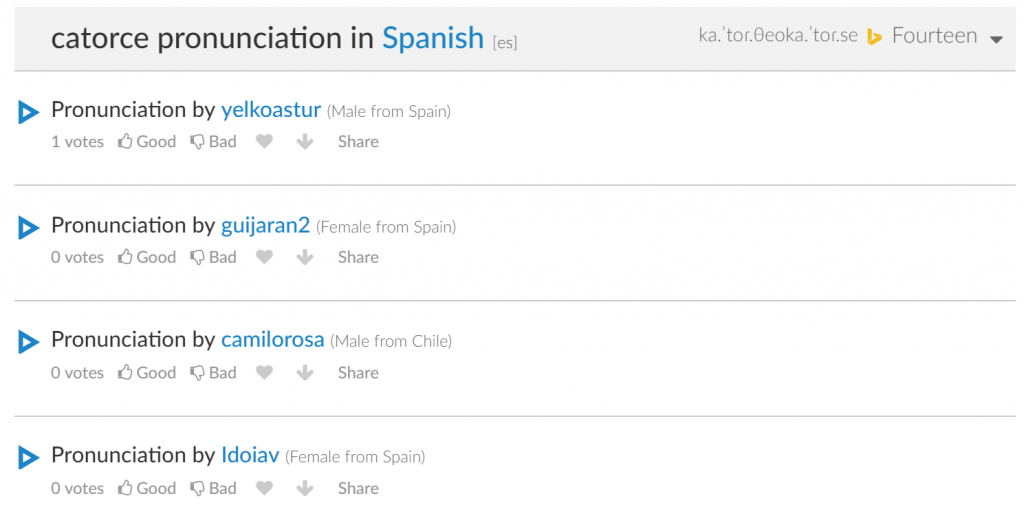
Once you’ve done all of that, it’s time to add them into Anki. You can find a tutorial on how to do that right here.
The app will then give you up to one minute to choose an answer to a flashcard, and you can select whether it was easy, good, hard or if you need to practise that card again.
By the end of the next seven days you’ll have a list for every day, similar to mine below (I last ran this with German):
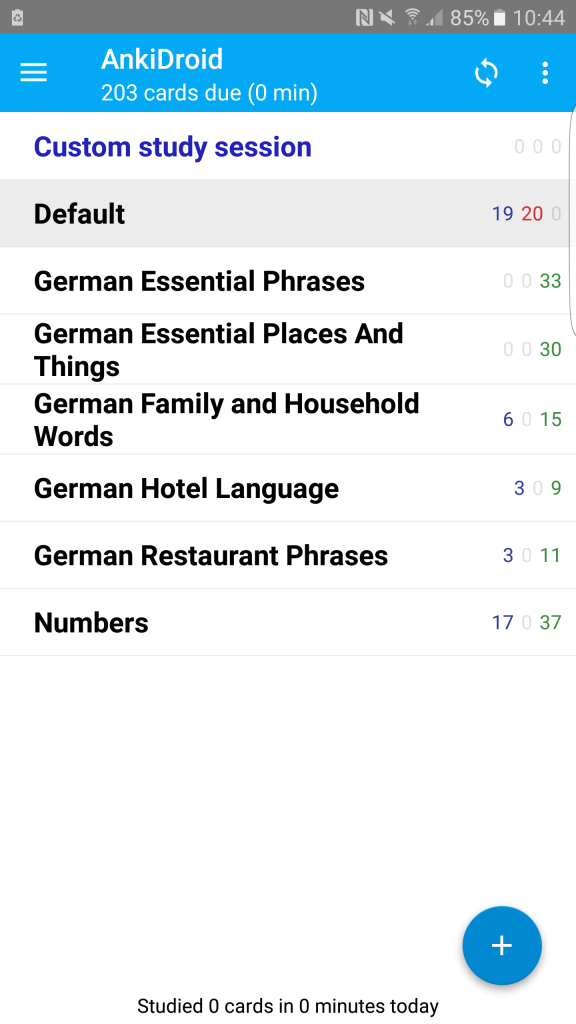
Knowing numbers always comes in handy, and not just for money. You can use it find the right bus, train platform or explain how many guests you need in your hotel room.
Greetings, on the other hand, go a long way with native speakers. I have no data to back it up, but I’ve seen around a 1000% increase in customer service quality when I use them.
If you’re stuck for what greetings you should learn, here’s where I’d suggest you start:
- Hello
- Good morning/afternoon/night
- How are you?
- Please
- Thank you
- Yes
- No
- Sorry
- The bill, please
- I don’t understand
Don’t worry if they don’t all stick right away because you’re going to come back to them later.
Step 2: Outline The Phrases You’ll Need (20-25 minutes)
In this step, you’re going to look at all the phrases you feel you’re going to need.
Take a look at your trip – or why you’re travelling – and think about the types of situations you’re going to encounter.
For example, I first used this technique when I was backpacking in Peru. So my survival situations looked like this:
Hostels
- Booking
- Checking in
- Checking out
Buses
- Finding the station
- Is it going to where I want to go?
- Which ticket do I need?
- How much does a ticket cost?
- How long does it take?
- Can you tell me when it’s my stop?
Restaurants
- Ordering food
- Paying
Supermarkets
- How much is this?
- Where is [item]?
Bars
- Ordering beer(s)
If I could get by with those, I could survive. Which, I did (just about). It also led to me going on Tinder dates and learning how to have conversations while giving me the confidence to take classes.
Go ahead and write all of the situations you’re going to need into a notebook or a Word document. You don’t need to write the translations just yet. This is where you’ll highlight the situations.
A pro tip here is also to underline the situations that are similar, like I’ve bolded the following:
- How much does a ticket cost?
- How much is an apple?
Because the first portion of the sentence will be the same:
- ¿Cuanto es un billete?
- ¿Cuanto es una manzana?
This will help you tie everything together in the days to come. Once you’ve got that in place, let’s head to the final step for today.
Step 3: Study What You Started With (Remaining Time)
Head back to Anki and see how much you remember from earlier.
It doesn’t matter if you don’t remember everything; you’ll be coming back to this each day. But work through the deck and do your best to remember them.
If you really struggle to remember any of them, try using mnemonics to etch them in your mind.
Day 2: Your Most Important Situation(s)
Start today off by reviewing your cards from yesterday.
Take 10 to 15 minutes to work through your greetings and numbers. See how much you remember, and refresh your memory on others.
The rest of today is going to be spent on putting together a list of phrases, and responses, to your two most important situations, which we’ll go through together next.
Learn Your Two Most Important Situations (Remainder)
When you made your list of situations there were likely one or two that really stood out to you. You may have rushed to write them down, or felt like you’d really struggle to get by without them.
For me it’s always public transport and ordering in a restaurant. I don’t like being lost or hungry (or both), so they’re of high importance.
So, it’s time to break them down from the list you made yesterday and explore the parts of the language you’re going to need to know.
What Are You Going To Need To Say?
If you’re in a restaurant, what are you going to need to say? Go through the process in English and look at the times you come into contact with someone:
- Ask for a table
- Ask for the menu
- Order a drink
- Order your food
- “Yeah, it’s nice…thank you”
- Order the bill
You can then start to translate the phrases you’ll need for those situations and learn what you need to say.
This takes some research on the internet. And, I don’t recommend you rely on Google Translate for this. Instead look for language-specific phrasebooks with English translations.
Once you find them you can start writing up your list of phrases. For example, in Spanish:
- “A table for four, please?” – “Una mesa para cuatro, por favor”
- “Can I see the menu?” – “Hay una carta?”
- “Can we order?” – “Podemos pedir?”
- “I’ll have a beer to drink” – “Una cerveza, por favor”
- “Can I have [name of food], please?” – “Me da [name of food on menu], por favor”
- “It’s lovely, thank you” – “Todo es muy rico!”
- “The bill, please?” – “La cuenta por favor”
A trap a lot of language learners fall into here – especially if you’re learning from a phrasebook – is you learn what you have to say, but not what they may say back to you.
So, you’re going to reverse this and put yourself in the shoes of the person you’re speaking to. In this case, the waiter.
You’ll never be able to predict their exact response. So because of that you should focus on learning the key words. Like the ones in bold here:
- “What would you like?” – “Que quieres?”
- “Would you like a drink?” – “…para tomar?”
- “What would you like to eat?” – “…para comer?”
- “Is everything okay?” – “Que tal todo?”
- “Yes, of course” – “Si, claro”
- “Would you like dessert?” – “Quieres postre?”
From those you can figure out what’s being asked based on the context.
Heck, with my intermediate Spanish I still use this method.
So, to wrap up this section:
Learn what you’re going to need to say
Learn what they’re going to say back to you
That way conversations don’t come as a surprise and you don’t feel panicked when someone asks you a follow-up question.
Days 3 and 4: Time to Start Listening
For days three and four, the schedule is the same for each.
You’re going to:
- Review each of the last few days (20-30 minutes): Go through Anki and review your flashcards. You should feel like you’re starting to get a grip of Day One and Two by the end of this.
- Tackle one new topic (30 minutes): As you saw in the last section, break down one of your topics and find the phrases and the responses to work through. Add them to Anki as you go for review later on.
- Listen to your language being spoken (10-15 minutes): I’m going to expand on this next so you know what to do.
- Review today’s Anki cards (remainder): Review what you learned in section two.
Now let’s look at what you can listen to and why you should be listening to it:
Listening to Your Language Being Spoken
So far you’ll have mostly heard your language through Forvo or YouTube examples. But today, you’re going to amp that up and do some intentional listening, where you hear the language spoken in context.
This allows you to pick out the sounds that you know, and listen to the general pronunciation of the language.
You don’t need to know what’s being said. It’s only been three or four days, so unless you’re a savant that’s pretty impossible. But taking the time to listen will make hearing people speak back to you much easier.
But, what should you be listening to? Well this is where YouTube really comes into its own. You can find:
- Podcasts: For language learners and natives
- Music: In just about every major language in the world
- Interviews: Find TV interviews in your target language
For example if you search “French Podcast” you’ll get a full page of results like this:
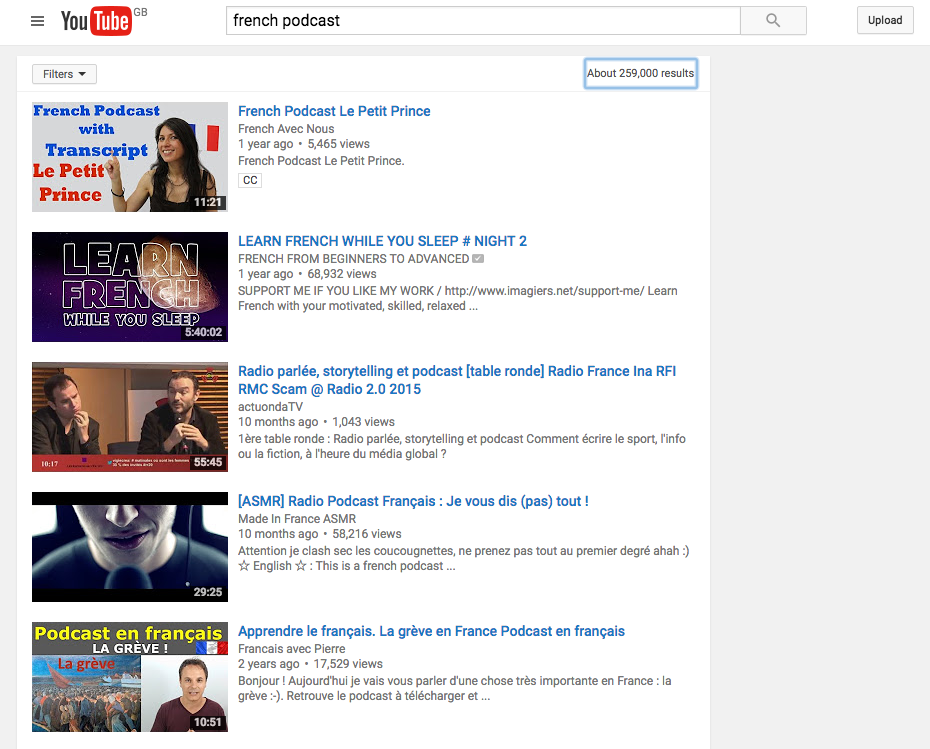
I like YouTube because it lets you see the mouth movements as well as the words. It makes it a little easier to pick the defined start and end of a word.
If you work from a computer – and your boss lets you listen to music while you work – you can incorporate this stage into your workday, too. (I feel I owe Julieta Venegas and Juanes at least $500 in Spanish lessons).
The important thing here is that you’re listening and absorbing the sounds. I feel this step made a big impact on my later Spanish and German pronunciation, so really give it some time.
Days 5 and 6: Time to Speak to Someone
By now you should be feeling pretty confident with what you learned on days one and two. And, days three and four are just about sinking in.
For the next two days you’ll follow a similar structure.
Start by reviewing the last few days. And, after that, work through any outstanding situations you have left. You can also continue to listen to music and podcasts if you like (foreign music is pretty cool, right?).
But the main change for these days is that you’re going to have a conversation with someone.
Don’t worry, it’s nothing major. Let me explain…
Get Talking To Someone
Having this conversation is really useful because It allows you to correct any mistakes you may be worried about before you need to use the language on your holiday.
You can also hear the responses you wrote earlier – and their variations – so you can pick out the words you know and improve your understanding.
And, from experience, I’ve found that when you say what you’ve learned, it sticks in your mind a heck of a lot longer.
If you have any friends or family that can speak the language you’re learning, collar them and get them to ask you a few simple questions based on your situations. (Pro tip: if they’re not able to do a real-time call or meet you in person, they can send WhatsApp or Facebook recorded messages).
But what if you don’t have anybody around you to talk to?
Then you can use italki. Here you’ll find hundreds of people here who are dying to speak English to you and will gladly swap a few sentences in their native tongue for the English practice.
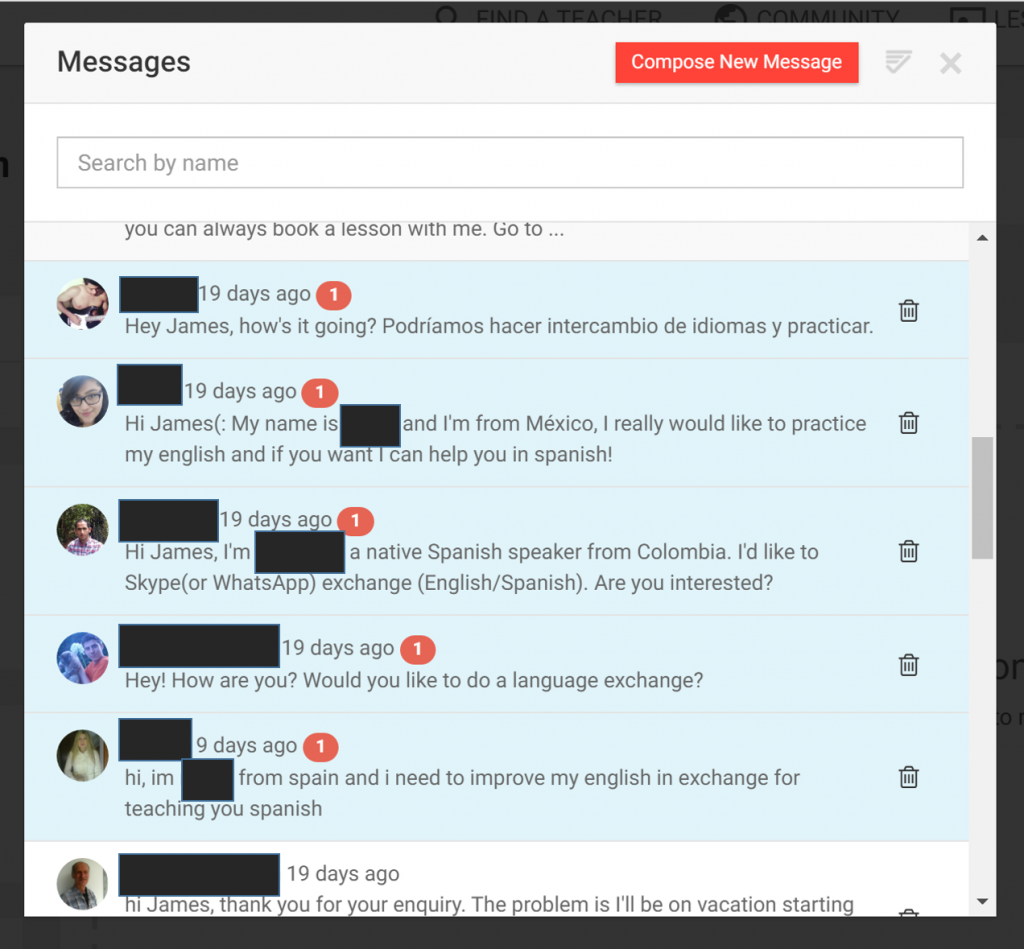
If this feels a little intimidating, you can fully explain what you’re trying to achieve in English before you jump onto Skype. I’m not really a telephone person, so I find this settles the nerves a little.
Okay, now you’ve got that in place, let’s look at the final day:
Day 7: The Finishing Touches
For the last day you’re going to work on anything that you struggled with over the previous six days.
Whether that is:
- Reviewing the phrases you struggle to remember
- Listening to YouTube videos and picking out the words you know
- Practising your phrases with someone on italki
I like to plan today to be the day that I fly, so I can use the language in practice. It’s also a good way to pass two hours on the plane by reviewing my flash cards and what I may need to say when I land.
If this is a few days ahead of when you travel, be sure to practise the flash cards and keep listening before you do fly. If you stop using a language when it’s this fresh in your mind, it’s easy to forget it.
And, if this is your first time using a new language, remember it doesn’t need to be perfect. This is about making the effort and getting your point across. You’ll be amazed at how helpful, and happy, people can be when you try to speak their language to them.
Wrapping It All Up…
Phew! If you made it here, well done. You’re either about to start this challenge or you’ve followed along and are now on your way to travel fluency.
Either way, you’ve taken a big step towards a new language, and getting rid of that English Guilt.
Here’s a summary of all the days:
- Day 1: Learn greetings and numbers. Then, map out all of the major situations you’re going to find yourself in.
- Day 2: Translate your two most important situations from English and look at the responses you’re likely to get. Be sure to focus on the keywords to listen out for.
- Days 3 and 4: Pick one more situation for each of these days. But, now is when we inject listening – podcasts/YouTube Videos/Music – into the mix.
- Days 5 and 6: Work on any outstanding situations, or your weak points. These days you’ll use to speak to someone and practise your phrases.
- Day 7: Review everything you’ve learned and tackle any points you struggled with.

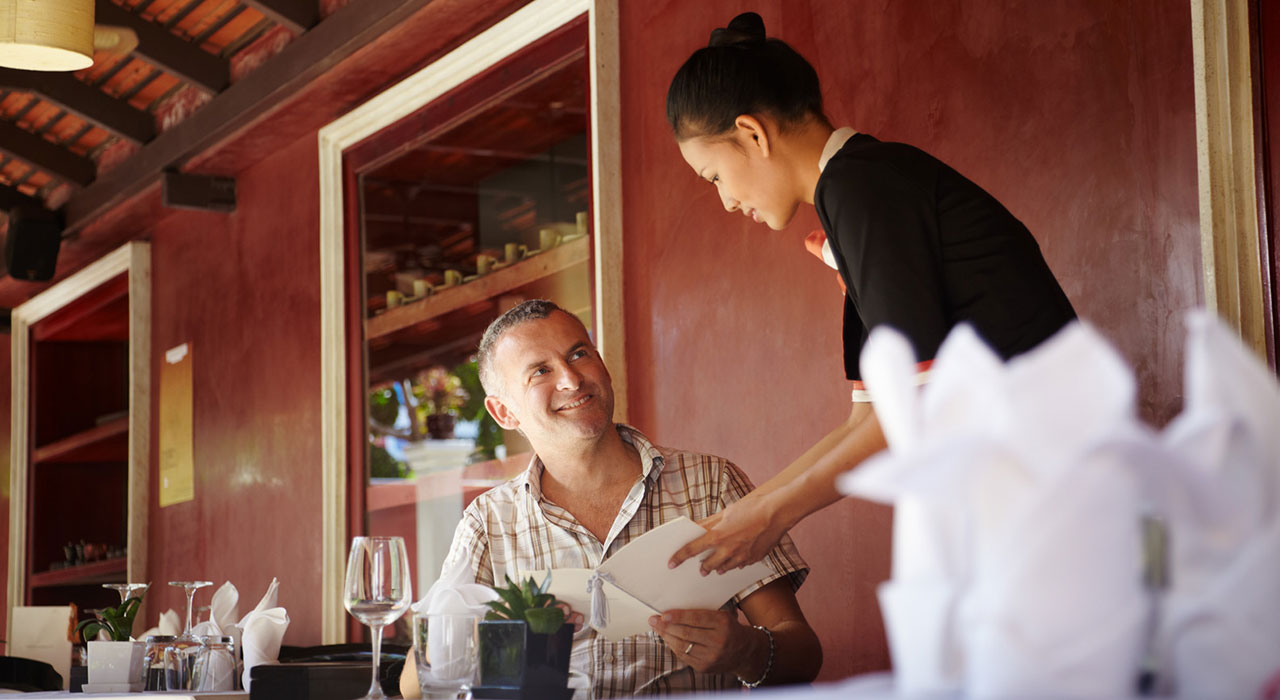

Social